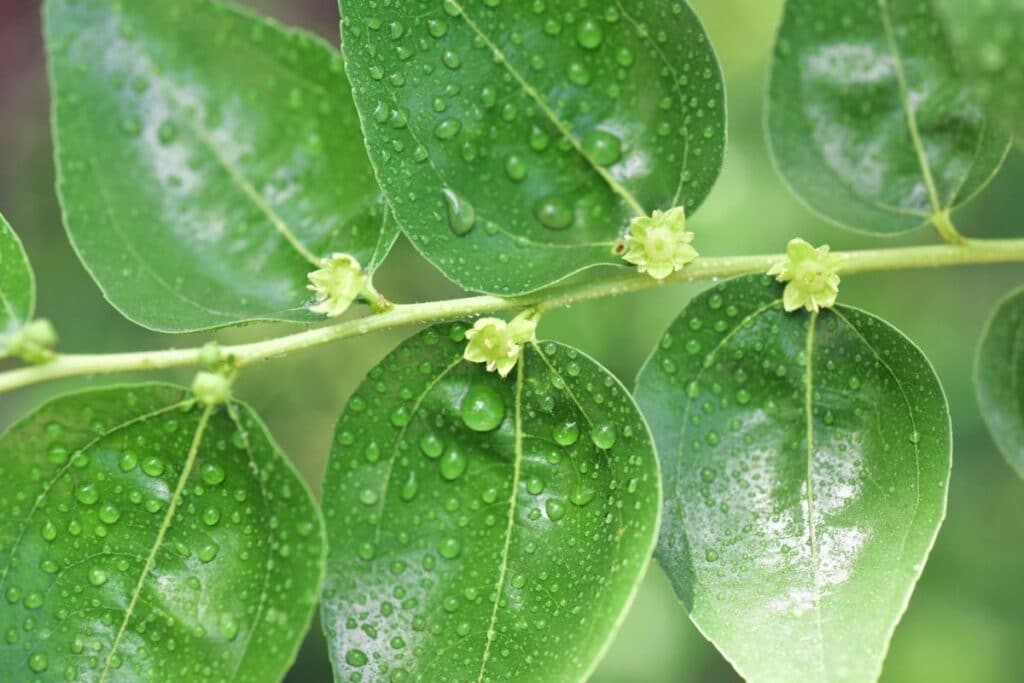You’ve probably heard of Jojoba oil before, but did you know that you can grow your very own specimen of this heat-loving evergreen shrub? In this article, you can read all about growing and caring for this useful desert plant.
What Is A Jojoba Bush
Jojoba (Simmondsia chinensis), which is actually pronounced ho-HO-ba is an evergreen shrub from the Simmondsiaceae family. This plant has many common names including gray box bush, quinine nut, pig nut, deer nut, and goat nut.
Jojoba plants are woody evergreen shrubs. Jojoba has thick, leathery leaves and is dioecious, which means that male and female flowers grow on separate plants.
Under natural circumstances, they usually grow to a height of around 6 feet (1.8m) and almost as wide. In very dry areas, these plants tend to take a dwarf, mounding growth form up to about 1.5 feet (0.45m) tall. In the garden setting with regular watering, however, these plants can grow much larger, sometimes reaching 10 feet (3m).
Even though the specific epithet of this plant’s Latin name suggests a Chinese origin, it is only found in the wild, dry country of the American Southwest. It occurs in Mexico and in the US states of Arizona and California.
These multi-stemmed shrubs have smooth bark and oppositely arranged, grey-green leaves. These leaves measure up to about 1.5 inches (38mm) long and an inch (25mm) wide and grow in an upright manner on the stems.
Jojoba Flowers
Jojoba plants are dioecious. The flower clusters of males plants are more obvious than the singular female flowers. The female flowers are much larger, however, measuring about 0.8 inches (20mm), compared with the 0.15 inch (4mm) male flowers.
Jojoba flowers are not of any real ornamental value. They are yellowish-green and produced in the early spring to early summer and also briefly after winter rain episodes.
These plants are better known for their useful fruits than for their flowers. Female plants produce these fruits, and then only if there are male plants nearby to fertilize them. The fruits start out pale green, and once ripe, they fall to the ground. Each fruit contains 1 seed (up to three seeds) that is 50% oil by weight.
How To Grow A Jojoba Bush
Growing jojoba plants is easy and requires minimal care.
You can quite easily grow your own plant from jojoba seeds that germinate within a week without special treatment. Stem cuttings are another option and they can be successfully rooted after about 2 months if kept under mist.
Jojoba plants grow in rocky or sandy soil that accepts water easily and drains freely. They have a good tolerance for saline soils with low nutrient content but are also tolerant of a variety of pH values from mildly acidic to mildly alkaline.
Jojoba tree grows best in full sun but light shade may be tolerated. These plants are tolerant of very high heat but do not survive frost well. They can be grown in lower rainfall areas in USDA zone 9 or 10.
Care and Maintenance
In the right environment, these are very low-maintenance plants that have a naturally neat and rounded growth form. They are not ideal for shearing, so use them for informal hedging or simply allow them to grow naturally in your landscape.
Jojoba grows actively in the summer and fall at a moderate rate. It is a very long-lived plant that is thought to survive for well over a century. Plants that are watered will need more frequent and heavier pruning. Resist the urge to irrigate these desert plants, unless you live in an area with less than about 16 inches (400mm) of annual rainfall.
Uses
Horticultural Uses
The natural growth form of this native desert shrub is rounded and quite neat, making it a fine choice for a low-maintenance informal hedge. It is also a fine plant for borders and foundation plantings, particularly in dry areas where options are more limited.
Human Uses
Jojoba plants are commercially cultivated in arid areas of many countries, including Australia, Peru, Argentina, Israel, and the United States. People have long known about the benefits of this plant and it has been used traditionally as a treatment for stomach complaints, wound healing as well as for maintaining animal hides. Today, the oil has industrial uses and is a very important ingredient in many cosmetic products like moisturizers, beauty and hair care products.
Wildlife Uses
Large animals like deer and livestock feed on the leaves of this plant, while smaller animals like squirrels and birds feed on the nuts. The flowers are wind-pollinated, and therefore do not attract insects.
FAQs
How long does jojoba plant take to grow?
Jojoba plants typically take several years, often around 3 to 4 years, to reach maturity and produce significant yields. However, they start developing seeds and can be harvested to a limited extent after about 2 to 3 years of growth.
What is the lifespan of a jojoba tree?
A jojoba tree can have a lifespan of 100 years or more, making it a long-lived perennial shrub. With proper care and growing conditions, it can thrive for several decades, providing a sustainable source of jojoba oil.
Conclusion
Jojoba is an interesting native evergreen shrub that is ideal for dry areas in Zone 9 and 10. These plants do not have showy ornamental qualities but are neat, low-maintenance, and a wonderful addition to the landscape. If you’re looking for a new shrub for your desert garden, why not try a Jojoba?
References
References
Oregon State University. Landscape Plants: Simmondsia chinensis
https://landscapeplants.oregonstate.edu/plants/simmondsia-chinensis
Matthews, R. F. Simmondsia chinensis. In: Fire Effects Information System
https://www.fs.fed.us/database/feis/plants/shrub/simchi/all.html
Stephens, J. M. Jojoba-Simmondsia chinensis
https://edis.ifas.ufl.edu/publication/MV083
California Native Plant Society: Jojoba-Simmondsia chinensis
https://calscape.org/Simmondsia-chinensis-()
University Of San Diego. Summary Of Jojoba And Its Traditional Use
https://www.sandiego.edu/kumeyaay-garden/plants/jojoba.php
Bahto, C. Homing In On Jojoba
https://cals.arizona.edu/maricopa/garden/html/pubs/1003/jojoba.html
Close
*image by coconat/depositphotos







